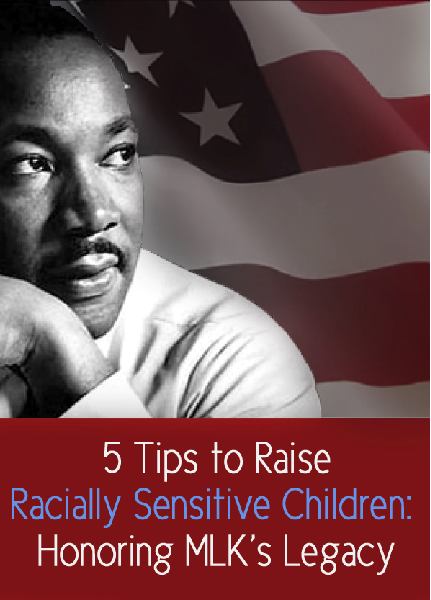5 Tips to Raise Racially Sensitive Children: Honoring MLK’s Legacy

“I have a dream that my four little children will one day live in a nation where they will not be judged by the color of their skin but by the content of their character.” ~Dr. Martin Luther King, Jr.
It has been a little more than 50 years since Dr. Martin Luther King Jr. delivered his I Have A Dream speech. As wife and momma in a multiracial family I know we’ve come a long way as a country since that time. Had my husband and I met in 1963, our marriage would have been illegal in 16 states. Forty-five years later, one in seven marriages is interracial. Yet, as I raise two biracial sons, I am keenly aware that we still have a long way to go. While laws and court rulings have played a pivotal role in redefining race relations in the United States (the Civil Rights Act of 1967 and the Supreme Court ruling against anti-miscegenation laws in 1967 are great examples), in the end each of us have a part to play in helping society move closer toward Dr. King’s dream.
Most of us would say that, yes, we think diversity is a good thing, and yes, of course we want to raise culturally sensitive children. Yet how do we go beyond paying lip service to this ideal? How do we go beyond talking about Dr. King’s dream one day a year to promoting an appreciation for diversity on a day-to-day basis?
Raising open-minded, compassionate, and culturally/racially sensitive children is a big focus in our home. In fact, I’d say it is probably one of our parenting priorities. Here are a few ways we nurture an appreciation for diversity with our boys. I hope it provides some inspiration for how your family can honor MLK’s legacy, all year long!
1. Don’t shy away from talking about race. Many people still believe that if we don’t talk to our kids about race, they just won’t notice it. But research shows they will notice it and they’ll just come to their own (often erroneous) conclusions, if we as parents fail to make it an open topic. If we talk openly and explicitly about race, our kids are more likely to have positive racial attitudes.
When kids ask questions, answer them honestly and openly. If you aren’t sure where or how to begin, books are always a great starting point. More on that in a minute! Another option is to search on-line for activities that encourage discussion about diversity. Over in the Playroom, BonBon’s Katie Myers explains how you can use playdough to explain diversity to young kids. Definitely check it out when you finish up here!
2. Make an effort to ensure diversity is reflected in your children’s books and toys, as well as what they see on television. Because I’m raising children of color, it is really important to me that they see themselves reflected in the world around them. Since they are kids, their world includes lots of books and toys. But regardless of your child’s color or ethnicity, what they see in their books and toys sends a message about the world at large. It can tell them “white people are the central characters” or it can tell them “people of all colors make up this world and deserve a role.” Depending on where you live it may require some hunting around to find diverse toys (we had to go on-line to find my son a black baby doll), but it is definitely worth it!
When it comes to books, we look for those that teach the value of differences but also books that show children of color just being and doing the things all kids do (so books that show diversity without being about diversity). Both are important. If you’d like some suggestions for good additions to your family library, check out our “diversity bookstore” where I’ve shared 20 or so of our family’s favorites for young kids (toddler through early elementary).
Click through to shop the full store!
3. Ensure your children have opportunities to interact with people from a variety of races and ethnicities. The best time to fight stereotypes is before they form. If our kids have had the opportunity to interact with people from different backgrounds, they have experiences that stand in contrast to stereotypes or negative things they might hear. They have the opportunity to experience people as individuals first, rather than as stereotypes.
We live in a pretty white community, but the adjoining town (which we are in the process of moving to) is much more diverse. For the past few years we’ve intentionally sought out activities in that town – swim lessons, sports – because we know it will give the boys a chance to interact with a more diverse group of kids. It also means we get to interact with a more diverse group of parents, which sends a powerful message to the kids. Other opportunities can include multicultural festivals, visiting restaurants with a more diverse clientele, or – if you live in a very homogenous area – a day trip to a more diverse community.
4. Look for ways to talk about differences as something to celebrate. Dr. King’s dream was not that people would not see his children’s color – it was that they would not judge his children by it. “Color-blind” is not the goal. The goal is to be able to recognize and celebrate differences without being limited by them or letting them determine the level of respect and consideration we afford one another.
In our home, we talk about race as one of many differences, all of which make the world an incredibly rich, interesting place. We look for ways the boys can learn about different cultures – often through books or tv shows – and when we talk about what they are learning, we try to do so with an attitude of respect and appreciation. We also talk about how, regardless of our differences, most people are the same when you get down to it. We want to be respected and loved and find joy in our lives. As the Sesame Street book says, “We’re different, we’re the same.”
5. Be aware of your own beliefs and attitudes. Just like children pick up on our emotions, they pick up on our feelings and attitudes toward people of other races and ethnicities, whether we communicate them out loud or not. We’ve all got our own baggage when it comes to race, whether we like it or not.
The best way to challenge our own racism is exposure and education. Without a doubt, my relationships with my husband and with friends of different races and cultures have raised my own awareness and cultural understanding in a way nothing else could. Nothing can replace a relationship when it comes to changing attitudes. But reading blogs by writers from different backgrounds and following sites that are focused on cultures or races other than my own have also been wonderful eye-openers and given me a lot to think about. When it comes to race, pretending it doesn’t affect us won’t get us anywhere. We need to be willing to admit that racism is a part of our culture and inevitably infects us all (to varying degrees), then be willing to work against it.
READ MORE FROM ELLIE
- Racist Rhymes & Teachable Moments
- Race in the Toy Aisle: What Do Children See?
- My Truth About Being A White Woman in a Mixed Race Marriage
 ABOUT ELLIE: Ellie is the editor of the Family Room at BonBon Break and blogs at Musing Momma, where she shares honest and personal stories ranging from reflections on motherhood to tips for raising healthy and (relatively) well-behaved kids, and from research on child development to fun family activities. As wife and mother in a multiracial family, she often writes about the intersection of race and family, and her experience raising two African-American/white sons. Ellie has a Ph.D. in psychology and counseled children and families for several years before changing paths to spend more time with her family. She resides in central Pennsylvania with her husband and their two adorably mischievous boys, ages 4 and 7.
ABOUT ELLIE: Ellie is the editor of the Family Room at BonBon Break and blogs at Musing Momma, where she shares honest and personal stories ranging from reflections on motherhood to tips for raising healthy and (relatively) well-behaved kids, and from research on child development to fun family activities. As wife and mother in a multiracial family, she often writes about the intersection of race and family, and her experience raising two African-American/white sons. Ellie has a Ph.D. in psychology and counseled children and families for several years before changing paths to spend more time with her family. She resides in central Pennsylvania with her husband and their two adorably mischievous boys, ages 4 and 7.
Follow Ellie on Facebook | Twitter | Google+ | Pinterest. You can subscribe to her blog here.
CONTINUE READING IN THE FAMILY ROOM
This post was written by Ellie of Musing Momma exclusively for Bonbon Break Media, LLC





